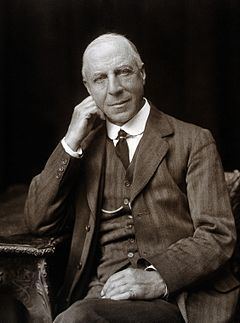Nationality English | Name Edward Sharpey-Schafer | |
 | ||
Books A Course of Practical Histology Education | ||
Sir Edward Albert Sharpey-Schafer FRS FRSE (2 June 1850 – 29 March 1935) was an English physiologist.
Contents
He is regarded as a founder of endocrinology: in 1894 he discovered and demonstrated the existence of adrenaline together with George Oliver, and he also coined the term "endocrine" for the secretions of the ductless glands. Schafer's method of artificial respiration is named after him.
Schafer coined the word "insulin" after theorising that a single substance from the pancreas was responsible for diabetes mellitus.
He was knighted in 1913.
Biography
Born Schäfer, Edward was the third son of city merchant James William Henry Schäfer who had been born in Hamburg but came to Britain as a young man, became a naturalised citizen and settled in Highgate, North London.
Edward attended Clewer House School and then University College London in 1868 where he was taught by the physiologist William Sharpey and became the first Sharpey Scholar in 1873. He was appointed Assistant Professor of Practical Physiology in 1874 and was elected to the Royal Society in 1878 when he was only 28 years old. He was Fullerian Professor at the Royal Institution and became Jodrell Professor at UCL in 1883, a position he held until 1899 when he was appointed to the chair of physiology at the University of Edinburgh where he remained until his retirement in 1933 and becoming Emeritus Professor thereafter. His chair was filled by Prof Ivan De Burgh Daly. Following the move to Edinburgh, he commissioned the Scottish architect Robert Lorimer to design a substantial family house at the coastal town of North Berwick.
Schafer was a founding member of the Physiological Society and from 1908 until 1933 edited the Quarterly Journal of Experimental Physiology. He was the recipient of many honorary degrees and prestigious medals both at home and abroad and his book on the Essentials of Histology ran to sixteen editions between 1885 and 1954. He introduced suprarenal extract (containing adrenaline as well as other active substances) into medicine. Schafer became a Fellow of the Royal Society in 1878, was president of the British Science Association in 1911–1912, was president of the British Medical Association in 1912 and was knighted in 1913.
Family
He was married twice, firstly to Maud Dixey and after her death in 1896, to Ethel Maud Roberts. There were four children by his first marriage, however, he outlived three of them: his eldest daughter died in 1905 and both his sons died in action in World War I. Following the death of his eldest son, John Sharpey Schafer, the name of ‘Sharpey', which had been given as a middle name, was prefixed by Schafer to his own surname in 1918, both in memory of his son and to perpetuate the name of his teacher, William Sharpey. His grandson, Edward Peter Sharpey-Schafer, was Professor of Medicine at St Thomas' Hospital, London from 1948 until his death in 1963.
His sister married James Cossar Ewart.
Students
His students included James Davidson Stuart Cameron and Alexander Murray Drennan.
Works
Besides valuable papers on muscular structure, on the chemistry of blood proteids, on absorption, and on the rhythm of voluntary contraction, he wrote:
He edited Quain's Elements of Anatomy (with G. D. Thane, 8th, 9th, and 10th editions).
